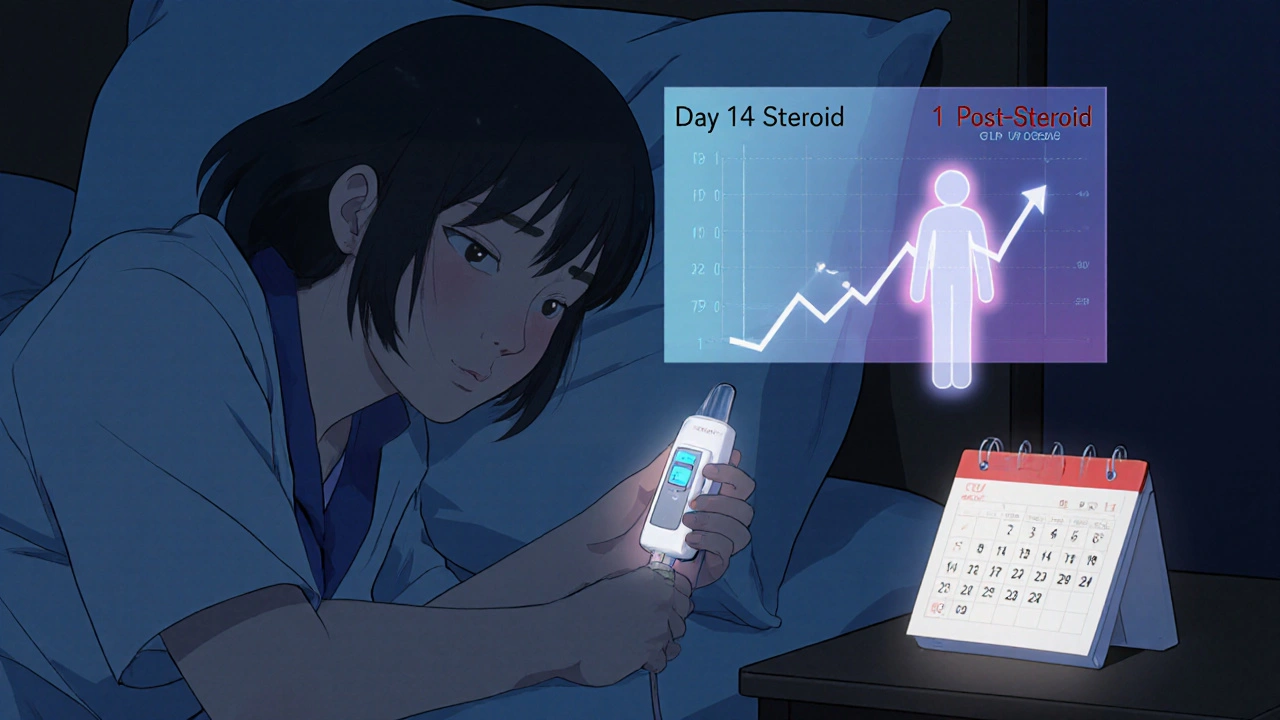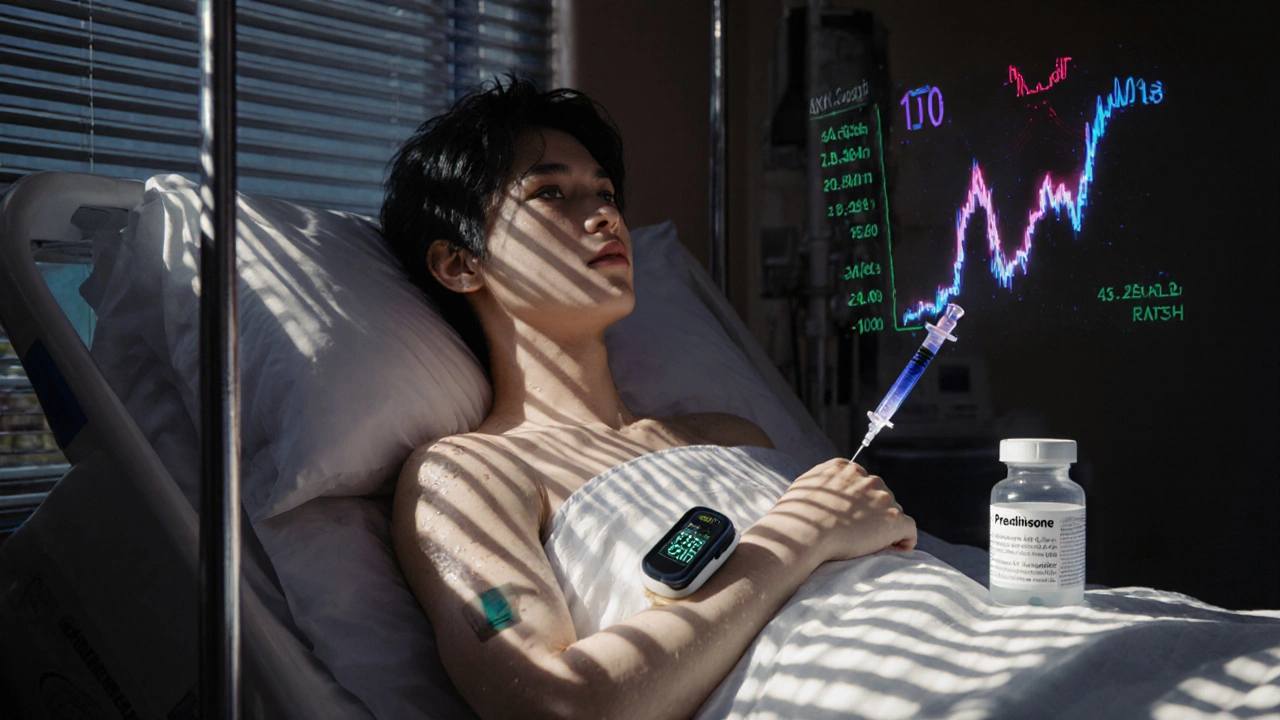Corticosteroid Insulin Adjustment Calculator
Steroid Therapy Management
Calculate appropriate insulin adjustments for patients receiving corticosteroids based on published clinical guidelines. This tool helps prevent dangerous glucose spikes and hypoglycemia during tapering.
Adjustment Recommendation
Calculate to see resultsEnter your steroid dose and patient information to see recommendations.
When you start taking corticosteroids - whether it’s prednisone for an autoimmune flare, dexamethasone for cancer treatment, or hydrocortisone after surgery - your body doesn’t just fight inflammation. It also starts fighting your blood sugar. Up to 50% of hospitalized patients on high-dose steroids develop dangerously high glucose levels, even if they’ve never had diabetes before. This isn’t just a side effect. It’s a distinct metabolic condition called corticosteroid-induced hyperglycemia, and if left unchecked, it can lead to coma, kidney damage, or prolonged hospital stays.
Why Steroids Raise Your Blood Sugar
Steroids don’t just make your body resistant to insulin - they actively sabotage it at multiple levels. In your liver, they crank up glucose production by nearly 38%, forcing your body to make more sugar even when you haven’t eaten. In your muscles, they block the main glucose transporter (GLUT4), so sugar can’t get into cells where it’s needed. Your fat tissue releases more free fatty acids, which further worsens insulin resistance. And in your pancreas, steroid doses as low as 75 mg of prednisolone can cut insulin output by over 20% within just two hours.
This isn’t like type 2 diabetes, where insulin resistance builds slowly over years. Steroid-induced hyperglycemia hits fast, hard, and often in a pattern you won’t see elsewhere: sharp spikes in the morning, followed by relatively normal levels later in the day. That’s because most steroids are taken once daily in the morning, and their effects last 16 to 24 hours. So your blood sugar rises as the drug peaks, then drops - but not always enough to be safe.
Who’s at Highest Risk?
Not everyone on steroids develops high blood sugar. But some people are far more likely to. If you have a BMI over 30, your risk jumps 3.2 times compared to someone with a normal weight. If you already have prediabetes or impaired glucose tolerance, your risk is nearly five times higher. Older adults, people with a family history of diabetes, and those on long-term or high-dose regimens (over 20 mg prednisone daily) are also at elevated risk.
Even if you’re otherwise healthy, if you’re getting steroids for rheumatoid arthritis, COPD, or lymphoma, you’re in the top three groups most affected. Rheumatology patients make up nearly 39% of all high-dose steroid users, followed by oncology and pulmonology. These aren’t rare cases - they’re routine.
How to Monitor Properly
Waiting for symptoms like excessive thirst or fatigue is too late. By then, your blood sugar may already be above 250 mg/dL. The standard of care now is to start checking glucose within 24 hours of starting steroids - not days later.
For high-risk patients, check your blood sugar at least twice a day: fasting in the morning and two hours after your largest meal. But here’s the catch: if you’re on a once-daily morning steroid, your peak glucose will be midday to afternoon, not at breakfast. That’s why many hospitals now recommend checking post-lunch levels too.
Continuous glucose monitors (CGMs) are becoming essential. One study found that 68% of patients with normal fingerstick readings were still having hidden spikes - especially at night. CGMs catch these, and they also warn of dangerous lows during steroid tapering, which happen in over 22% of patients. These lows aren’t from too much insulin - they’re from your body suddenly regaining insulin sensitivity as the steroid leaves your system.

What to Do When Blood Sugar Rises
Sliding scale insulin - where you give a fixed dose based on a single reading - doesn’t work well for steroid-induced hyperglycemia. It’s reactive, not predictive. The best approach is a basal-bolus insulin regimen: a long-acting insulin once or twice daily to cover background glucose production, plus rapid-acting insulin before meals to handle spikes.
For patients with pre-existing diabetes, expect to increase your total insulin dose by 20% to 50%. For those without prior diabetes, insulin is often needed if two consecutive readings exceed 180 mg/dL. Don’t delay. The Mayo Clinic’s protocol, which starts insulin automatically at that threshold, has cut complications by over half.
Oral diabetes drugs like metformin or SGLT2 inhibitors? They’re not useless, but they’re not enough. Steroid-induced hyperglycemia is too severe and too rapid for pills alone. Insulin is still the gold standard during active steroid treatment.
Managing the Taper - The Hidden Danger
The biggest mistake? Thinking the problem ends when the steroid does. As the dose drops, your insulin resistance fades - but your body’s insulin production hasn’t caught up yet. That’s when blood sugar crashes. Patients report sudden sweating, shaking, and confusion during tapering, often at night or early morning.
That’s why insulin doses must be reduced gradually - not abruptly. Many hospitals now use a 20-25% reduction in insulin for every 5 mg drop in prednisone. And you should keep checking glucose daily for at least a week after the last steroid dose. Some patients need insulin for weeks after stopping steroids, even if they never had diabetes before.

Why Hospitals Are Still Falling Short
Despite clear guidelines from the American Diabetes Association and Endocrine Society, only 58% of non-critical care units have formal protocols for steroid-induced hyperglycemia. That means in nearly half of hospitals, nurses aren’t trained to check glucose on steroid days, doctors don’t know to adjust insulin for timing, and patients are sent home without follow-up plans.
One study found patients in hospitals without protocols waited 43% longer to get treatment. Another showed that 32% of insulin errors were due to mismatched timing - giving a long-acting insulin at night when the steroid was still peaking, then forgetting to reduce it when the steroid wore off.
Even providers get confused. Only 44% of non-endocrinology physicians correctly identify the morning glucose spike as the hallmark pattern. That’s not just ignorance - it’s systemic neglect.
What’s Next: Better Tools and Safer Drugs
The future is coming fast. The NIH is testing a machine learning tool that predicts your personal risk of steroid-induced hyperglycemia using your BMI, HbA1c, steroid type, and even a genetic marker called GR-1B. Early results show 84% accuracy. Imagine knowing before you even start steroids whether you’ll need insulin - and how much.
Meanwhile, drug companies are developing “steroid-sparing” drugs and tissue-selective glucocorticoid receptor modulators. These new agents aim to block inflammation in joints and lungs without hitting the liver, muscles, or pancreas. Three are already in Phase II trials, and early data shows they cut hyperglycemia risk by over 60%.
For now, the answer is simple: monitor early, treat aggressively, taper carefully. Steroids save lives. But without proper glucose management, they can also put them at risk.


Jenny Lee
November 19, 2025 AT 17:02This is wild-I had no idea steroids could wreck your glucose so fast.
Saket Sharma
November 21, 2025 AT 10:09Basal-bolus is non-negotiable. Sliding scale is medieval. If your hospital still uses it, they’re practicing medical malpractice by omission.
mithun mohanta
November 21, 2025 AT 19:10Let’s be real-the pharmaceutical-industrial complex doesn’t want you to know that steroids are just slow-acting poison with a prescription label. They profit from insulin, not from prevention.
And don’t get me started on CGMs-those things are $1000/month, and insurance won’t cover them unless you’re already in diabetic coma. Capitalism wins again.
Shravan Jain
November 23, 2025 AT 09:45Therapeutic nihilism is the only rational response to a system that treats metabolic collapse as a side effect rather than a systemic failure. We are not patients-we are data points in a profit algorithm.
Insulin is not a cure. It’s a bandage on a severed artery. And the doctors? They’re just the janitors cleaning up the mess after the machine breaks.
Evan Brady
November 24, 2025 AT 20:11For anyone on steroids: if you’re above 180 mg/dL twice, start insulin. Don’t wait. I’ve seen people get DKA from ‘just a little prednisone.’ It’s not a joke.
And yes-tapering is the silent killer. I had a patient crash at 3 AM three days after his last dose. No one saw it coming because they thought the steroid was ‘out of his system.’ It’s not that simple.
Richard Couron
November 26, 2025 AT 17:22They’re lying to you. The FDA knows this. The AMA knows this. They let this happen because Big Pharma makes more money off insulin pumps and glucose monitors than they ever did selling steroids. You think this is medicine? It’s a money-printing machine disguised as a hospital.
And don’t you dare say ‘it’s for your health.’ My uncle died from a steroid-induced coma. They called it ‘complications.’ I call it murder by bureaucracy.
Brandon Lowi
November 27, 2025 AT 09:48America’s healthcare system is a circus-and steroids are the clown car. We treat symptoms like they’re the disease. We don’t fix the damn system. We just hand out more pills and call it progress.
Meanwhile, in Germany, they screen everyone on steroids for glucose intolerance within 12 hours. We’re still arguing over whether to check it at all. Pathetic.
Premanka Goswami
November 28, 2025 AT 06:20EVERYTHING IS A LIE. The ‘science’ behind steroids? Manufactured by the same labs that sell insulin. The ‘guidelines’? Written by doctors on pharma payroll. The ‘new ML tool’? Just another way to sell more devices.
They want you to believe you need constant monitoring because you’re broken. But you’re not broken-you’re being exploited. The real disease is trust in institutions. And they know it.
They’re not trying to save you. They’re trying to monetize your suffering. Wake up.
Erica Lundy
November 29, 2025 AT 22:43It is an ontological paradox: the very agents designed to restore homeostasis in inflammatory pathways simultaneously induce metabolic dysregulation of such magnitude that the organism becomes a site of self-inflicted pathology.
The glucocorticoid receptor, while evolutionarily conserved for stress adaptation, becomes a Trojan horse when pharmacologically overstimulated-subverting hepatic gluconeogenesis, peripheral insulin signaling, and pancreatic β-cell function in a cascade that mirrors, yet accelerates, the pathophysiology of metabolic syndrome.
Thus, the clinical imperative is not merely therapeutic intervention, but epistemological humility: recognizing that pharmacological power, untempered by physiological wisdom, is a form of violence.
Alex Boozan
December 1, 2025 AT 02:52CGMs are not a luxury-they’re a biological necessity. If you’re on steroids, you’re not managing diabetes. You’re managing a chemical war inside your body. And you need real-time intel.
Stop relying on fingersticks. They’re like checking your car’s oil with a flashlight in a thunderstorm. You’re missing half the picture.
Ram tech
December 1, 2025 AT 09:17why do u even care about sugar if u on steroids? just take the meds and chill. its not that complicated.
Kevin Jones
December 2, 2025 AT 07:32The morning spike isn’t a coincidence-it’s a signature. Like a fingerprint of the drug’s half-life. If your glucose monitor doesn’t reflect that rhythm, you’re not monitoring-you’re guessing.
And the taper? That’s when the body screams. Not with pain-with panic. Insulin resistance vanishes overnight. Your pancreas? Still asleep. That’s when the crashes hit. Quiet. Deadly.
Joshua Casella
December 2, 2025 AT 13:50I’ve worked in 3 hospitals, and this is still not standard. Nurses don’t know to check post-lunch. Docs don’t adjust insulin for timing. It’s not negligence-it’s ignorance, and it’s killing people.
Let’s make a checklist. Every patient on steroids: glucose check within 24 hours. CGM if possible. Basal-bolus if >180 twice. Taper insulin 20% per 5mg prednisone drop. Follow-up in 7 days.
It’s not rocket science. It’s basic care. Why is this so hard?
Riohlo (Or Rio) Marie
December 3, 2025 AT 09:02Of course the system fails. You think a profit-driven medical complex gives a damn about your pancreas? Your insulin sensitivity is just a line item on their quarterly report.
The ‘new’ tissue-selective glucocorticoids? Don’t be fooled. They’ll cost $12,000 a year. Only the rich will get them. The rest of us? Still stuck with prednisone and a prayer.
They call it medicine. I call it class warfare wrapped in white coats.
Alexis Paredes Gallego
December 5, 2025 AT 03:01Wait-so you’re telling me the government and Big Pharma are secretly using steroids to create a diabetes epidemic so they can sell more insulin? That’s not conspiracy-that’s the business model.
I read a leaked memo once. It said ‘steroid-induced hyperglycemia is a market expansion opportunity.’ I didn’t believe it… until my cousin died with a glucose of 920.
They’re not treating you. They’re harvesting you.